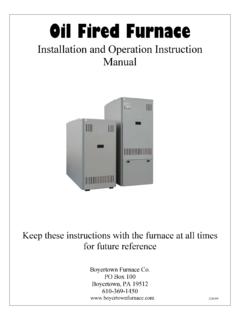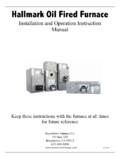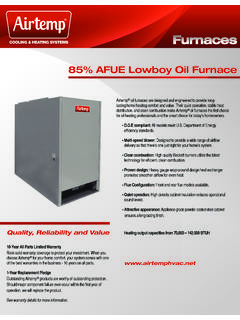Transcription of FURNACE OIL (FO) - Stallion Energy Pvt. Ltd.
1 FURNACE OIL (FO) Definition: A dark viscous residual fuel obtained by blending mainly heavier components from crude distillation unit, short residue and clarified oil from fluidized catalytic cracker unit. Nomenclature: Bunker fuel, FURNACE oil, Fuel oil are other names for the same product. Though Fuel oil is a general term applied to any oil used for generation of power or heat, Fuel oil can included distillates and blends of distillates and residue such as Light Diesel Oil. Specification: FURNACE oil in the current marketing range meets Bureau of Indian Standards Specification IS : 1593 - 1982 for fuel oils, grade MV2. Viscosity: Viscosity is the most important characteristic in the FURNACE oil specification. It influences the degree of pre-heat required for handling, storage and satisfactory atomization. If the oil is too viscous it may become difficult to pump, burner may be hard to light and operation may be erratic.
2 Poor atomization may result in the carbon deposits on the burner tips or on the walls. The upper viscosity limit for FURNACE oil is such that it can be handled without heating in the storage tank is excepting under server cold conditions. Pre-heating is necessary for proper atomization. Flash Point: As per the Controller of Explosives classification, FURNACE oil falls in the class "C" category with minimum flash point standard of 66 deg. C. Since Penskey Martens Closed Cup method is used, it is apparent that a small quantity of low boiling point hydrocarbons is sufficient to lower the flash point drastically. Pour Point: It is a very rough indication of the lowest temperature at which FURNACE Oil is readily pump able. In the specification the pour point of FURNACE oil is not stipulated. However, for FURNACE oil manufactured indigenously and for imported parcels, the pour point is such that current supplies normally can be handled without heating the fuel oil handling installation.
3 Water: Water may be present in free or emulsified form and can on combustion cause damage to the inside FURNACE surfaces especially if it contains dissolved salts. It can also cause sputtering of the flame at the burner tip. Water content of FURNACE oil when supplied is normally very low as the product at refinery site is handled hot and maximum limit of 1% is specified in the standard. Sediment: FURNACE oil being a blend of residues contains some quantity of sediments. These have adverse effect on the burners and cause blockage of filters etc. However, the typical values are normally much lower than the stipulated value of maximum percent, by mass. Ash: Ash is incombustible component of the FURNACE oil and is expressed as a percentage mass of the FURNACE oil sample. Ash consists of extraneous solids, residues of organ metallic compounds in solution and salts dissolved in water present in the fuel.
4 These salts may be compounds of sodium, vanadium, calcium magnesium, silicon, iron etc. Ash has erosive effect on the burner tips, causes damage to the refractories at high temperatures and gives rise to high temperature corrosion and fouling of equipments. Sulphur: Sulphur determination includes burning of known quantity of oil, treating the sulphur oxidation products formed during combustion and weighing of sulphur in the form of sulphate. The sulphur di-oxide may come in direct contact with the product during the combustion process and may create adverse quality effects in the product. Calorific Value: Calorific value of a fuel is the quantity of heat generated in kilocalories by complete burning of one kilogram weight of fuel. Gross calorific value is higher than net calorific value to the extent of heat required to change water formed by combustion into water vapours. TYPICAL PROPERTIES (RELIANCE) PARAMETER METHOD UNIT LIMIT RESULT MIN MAX Vanedium, Aluminium+Silicon, Calcium By ICP MS Mg/kg 300, 25, 30 213, , Ash D:482 Gross Calorific Value IS 1448 Kcal/kg 10100 - 10142 Relative Density @15 C D:1296 Kg/l - Flash Point (PMCC) D:93 C - 100 96 Kin.
5 Viscosity @ 50 C D:445 CSt 300 Sediment D:473 Wt % - Total Sulphur D:4294 Wt % - Water Content D:95 Vol % - Pour Point D:97 C - +12 +9 TYPICAL PROPERTIES (IMPORTED) PARAMETER METHOD UNIT RESULT Density @ 15 C ISO 3675 Kg /1 Flash Point ISO 2719 C 91 Kinematic Viscosity @50 C ISO 3104 Cst Pour Point ISO 3016 C -6 Sulphur ISO 8754 % (m/m) Total Sediment, Potential* ISO 10307-2 %wt Water ISO 3733 %v/v Ash 550 C ISO 6245 %(m/m) Gross Calorific Value Calculation K. Cal/Kg 10122 Sediment by Extraction* ASTM D 473 % wt Micro Carbon Residue ISO 10370 % Vanadium* IP 501/05 Mg/kg 77 Aluminium + Silicon * <15 Calcium * 6 Zinc * 1 Phosphorous * <1








